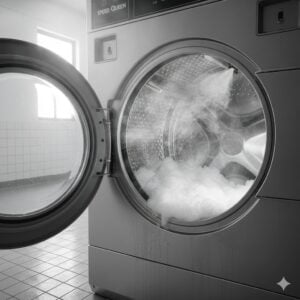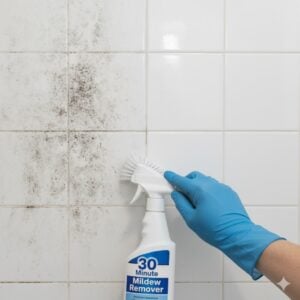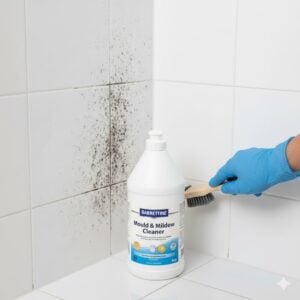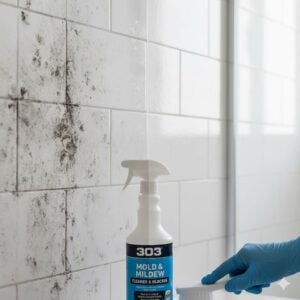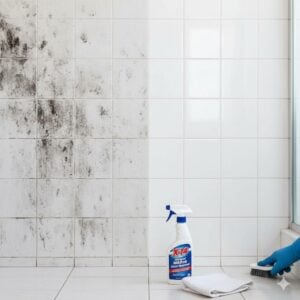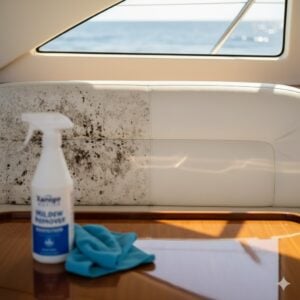That “wet carpet smell” isn’t just annoying—it’s a warning. In UAE homes, the mix of AC-cooled rooms, occasional leaks, balcony rain blow-in, and pet accidents means carpets can trap moisture fast. If you notice a musty, sour, or “wet dog” odor, act quickly. Within 24–48 hours, moisture inside carpet fibers and padding can support mildew or mold growth, damage the subfloor, and trigger allergies. In this long, practical guide, we explain why wet carpet smells happen, what you can do immediately, when to DIY, when to call a pro, and how to keep your carpets fresh in Dubai, Abu Dhabi, and across the Emirates.
Table of Contents
Toggle1. Why Wet Carpet Smell Happens
Carpets are layered systems: face fibers, backing, underlay/padding, and often a timber or concrete subfloor beneath. When water enters (spills, AC condensate, window leaks, balcony mop water, pet accidents), it doesn’t just sit on top—capillary action wicks it downward. Odor develops because:
- Moisture + organic matter (skin cells, food crumbs, pet dander) allow bacteria and mildew to multiply, releasing musty volatile compounds.
- Underlay/padding acts like a sponge. Even if the surface feels dry, the pad can hold liters of water and keep smelling.
- Urine crystals from pets reactivate with humidity, producing a strong ammonia-like smell days or weeks later.
- Hidden sources—AC drip pans overflowing, window condensation running under skirtings, tiny plumbing leaks—keep re-wetting the same zone.
In short: if the odor persists, the moisture (or residue) persists. Surface sprays can mask it, but only proper extraction and drying remove the cause.
2. Is Wet Carpet Smell Dangerous?
Sometimes it’s “just” stale moisture; other times it’s a health risk. Here’s how to think about it:
Low risk: recent clean-water spills dried within 24 hours, no odor after thorough extraction and ventilation.
Moderate to high risk: odors lasting beyond 24–48 hours; visible mildew; people in the home developing sneezing, coughing, irritated eyes; vulnerable family members (kids, elderly, asthma). If the water came from unclean sources (backed-up drains, washing machine overflow that sat, AC condensate full of biofilm), treat it as higher risk. Unchecked, persistent damp can invite mold growth, which is tougher and more expensive to fix.
Rule of thumb: if you can smell “musty,” microbes are active. The nose is a good early detector—don’t ignore it.
3. Immediate Steps: The First 24 Hours

Move fast. The sooner you remove moisture, the less chance for odor and damage.
- Stop the source. Turn off leaking appliances/AC, shut valves if needed, close windows during sand-rain, place towels at door gaps.
- Extract, don’t just blot. Use a wet/dry vacuum to pull water up and out of the fibers. Work slowly in overlapping passes. If you don’t have one, press with absorbent towels and replace as they saturate.
- Lift airflow. Point fans across (not directly down) the carpet to move air. Run AC on “dry” or pair fans with a dehumidifier (target indoor RH ~45–55%). Open windows if outdoor humidity is lower.
- Treat the spill type. For pet accidents, use an enzyme-based cleaner to break down urine crystals. For food/milk, use a mild detergent solution (patch-test first). Avoid over-wetting; residues feed future odors.
- Check edges. Gently lift a corner near skirting board (if feasible) to see if the underlay is wet. If it is, you’ll likely need deeper extraction—and possibly pad replacement—especially if smell persists.
- Remove furniture from the wet zone (protect feet with foil or plastic). Wood stains and rust from metal legs can permanently mark damp carpet.
Caution: Excess heat (steam, hairdryers) can set stains and warp backing. Strong bleach on carpet fibers can cause color loss and lingering chemical odor—avoid unless a pro advises it.
4. Deep-Drying: Home vs. Professional Methods
At home (for small, fresh incidents):
- Continue wet-vac extraction until little water lifts.
- Lightly rinse with clean water (spritz, don’t soak) and extract again to remove residues that cause odors.
- Apply a fabric-safe antimicrobial or enzyme cleaner per label (patch-test).
- Run fans + dehumidifier for 12–24 hours. Re-check the pad by touch or with a moisture meter if you own one.
Professional approach (best for strong odors, repeated incidents, large areas, or pad saturation):
- Subsurface extraction: High-flow tools pull moisture from beneath the carpet and pad, not just the face fiber.
- Pad assessment/replacement: If the pad is saturated or smells, pros can lift the carpet, replace sections of underlay, and re-stretch it properly.
- Hot water extraction (HWE): Also called “steam cleaning,” this flushes soils and odor residues, then extracts immediately. When done correctly, it speeds dry time, it doesn’t prolong it.
- Targeted treatments: Enzymes for urine, oxidizers for organic odors, and safe antimicrobial rinses as needed. For severe cases, air filtration with HEPA and controlled deodorization can be used.
If you’re in doubt—or the smell returns—professional help saves time and prevents subfloor damage. Just click the contact button on the right-middle of this post and we’ll assess your case quickly.
5. Troubleshooting Stubborn Odors
If the carpet still smells after your best effort, isolate the culprit. Use this quick map:
| Likely Source | Clues | Best Fix |
|---|---|---|
| Wet underlay/pad | Surface feels dry but odor lingers; edges feel cool/damp | Subsurface extraction; lift & replace pad section; antimicrobial treatment |
| Pet urine crystals | Smell intensifies on humid days; localized spots | Enzyme flush + extraction; pad treatment or replacement in severe cases |
| Subfloor or skirting | Odor near walls; visible swelling or staining | Dry and treat timber/concrete; address leak; replace tack strips if needed |
| HVAC moisture | Smell stronger when AC runs; nearby vent condensation | Service AC drain/filters; dehumidify; improve airflow path |
| Residue left in fibers | Sticky feel; re-soiling quickly | Proper rinse extraction to remove detergents/soils |
6. UAE-Specific Prevention: Keep Carpets Fresh
Prevention in our climate is all about moisture control and quick response:
- Mind the AC: Service drain lines, keep filters clean, and avoid extreme thermostat swings that cause condensation.
- Entry mats + shoe policy: Catch balcony rain drips, mop water, and sand that holds moisture. A “shoes off” habit protects fibers.
- Deal with spills immediately: Extract, rinse-lightly, extract again. Don’t leave “to dry later.”
- Watch windows & doors: Condensation can run down and wick under carpet. Use weather seals and wipe sills.
- Space furniture: Leave small gaps from walls so air can circulate; use sliders to move pieces during cleaning.
- Schedule deep cleaning: A professional wash/extraction every 6–12 months removes residues that cause future odors.
7. When to Call a Professional (and What to Expect)
Call a pro when:
- Odor returns after DIY drying.
- You suspect the pad/subfloor is wet.
- There’s visible mildew, or family members have allergy symptoms around the affected area.
- The spill involved a large volume, sewage/greywater, or sat for more than 24 hours.
What we do: inspect the source, measure moisture, perform subsurface extraction, treat with the right chemistry (enzymes/antimicrobials), and accelerate drying with professional air movement and dehumidification. If necessary, we’ll lift sections, replace the underlay, and re-stretch the carpet to manufacturer tension so it looks and smells like new.
Every case is different, so we keep things simple: quick assessment, clear plan, and practical tips you can use to prevent a repeat. If you want straight advice (no pressure), just click the contact button on the right-middle of this post—we’re happy to help.
8. FAQ: Quick Answers You Can Use Today
How long until a wet carpet starts to smell? Often within 12–48 hours, depending on temperature, humidity, and what spilled. Faster in closed, AC-cooled rooms.
Can baking soda fix it? It can absorb light odors but won’t remove moisture in the pad. Always extract first; vacuum thoroughly after baking soda.
Will sunlight help? Sunlight helps kill microbes, but most UAE homes have fitted carpets you can’t drag to the balcony. Focus on extraction and dehumidification indoors.
Is vinegar safe? Diluted white vinegar can neutralize some odors, but always patch-test. It won’t cure a soaked underlay.
What if the smell is “sweet” or “rotten”? Unusual odors can indicate bacteria or contaminated water—get a professional inspection.
Conclusion
Wet carpet smell is solvable—but speed matters. Extract the water, control humidity, and tackle the exact cause (urine residues, wet underlay, hidden leaks). For small, fresh spills, a careful DIY can work. For persistent or strong odors, lifting and subsurface treatment are usually the fastest, safest route to a fresh, healthy home.
If you’d like a clear plan for your specific situation, just click the contact button on the right-middle of this post. We can diagnose the source, dry it properly, and help you prevent it from coming back—so your carpets smell clean again, day after day.








